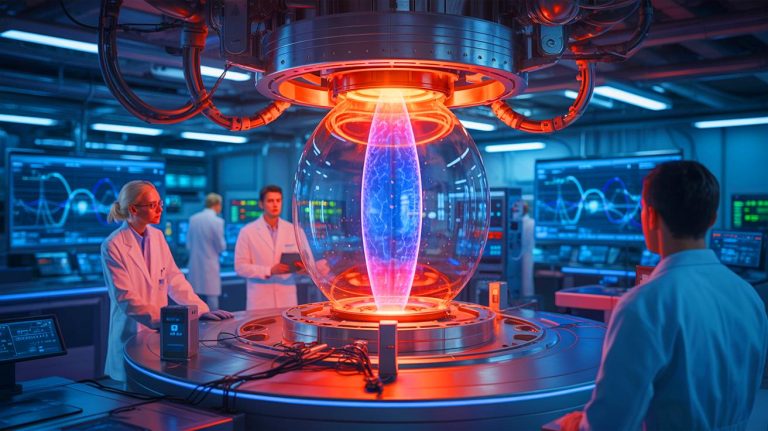| IN A NUTSHELL |
|
The Los Alamos National Laboratory (LANL), in partnership with the Lawrence Livermore National Laboratory (LLNL), has achieved a remarkable milestone in the field of fusion science. This groundbreaking experiment, conducted at the National Ignition Facility (NIF), successfully achieved fusion ignition using an innovative diagnostic platform called the Thinned Hohlraum Optimization for Radflow (THOR) window system. The experiment not only generated a fusion energy yield of 2.4 megajoules but also produced a self-sustaining “burning plasma.” This significant achievement highlights the potential of fusion energy to address critical scientific and practical challenges and paves the way for future advancements in energy production.
First Operational Test of THOR
The recent experiment marked the first operational test of LANL’s Thinned Hohlraum Optimization for Radflow (THOR) window system. Primarily designed to provide a source of high-flux X-rays, the system is used to study material responses to extreme radiation environments. LANL physicist Joseph Smidt emphasized its significance, noting that the experiment showcases the capability of their designs to create fusion ignition conditions, which are crucial for stockpile stewardship.
Typically, in an NIF experiment, lasers are directed into a gold-coated cylinder, known as a hohlraum, which contains a capsule of deuterium and tritium fuel. The lasers generate X-rays inside the hohlraum, causing the fuel capsule to implode symmetrically and initiate fusion. This experiment represents an essential step forward in advancing fusion science and expanding its applications, setting a new benchmark for future research.
Modifying the Standard Hohlraum
The THOR design introduces a modification to the standard hohlraum by incorporating windows that allow some of the generated X-rays to escape. These escaping X-rays are used to irradiate test materials, enabling scientists to study radiation flow and energy absorption. One of the primary challenges in designing the THOR hohlraum was managing energy loss and potential asymmetry.
The process of fusion ignition is highly sensitive to the energy balance of implosion, and the introduction of windows can create an exit path for X-ray energy, potentially disrupting the uniformity needed for fuel capsule compression. LANL physicist Brian Haines highlighted the sensitivity of igniting capsule implosions to energy loss, underscoring the experiment’s success in validating computer simulations used to design the platform.
Expanding Applications of Ignition Platform
While LLNL first achieved ignition in 2022, this experiment represents a crucial step in expanding the applications of the ignition platform. Lab physicist Ryan Lester stated that the experiment validates high-fidelity simulations and demonstrates ignition-scale performance even with THOR platform modifications. With the viability of the THOR concept now established, researchers plan further development.
Future work will focus on refining the windows to increase transparency and designing experimental packages to attach to the hohlraum. This will enable the collection of data on material properties under plasma conditions, previously unattainable in laboratory settings. These advancements are expected to significantly broaden the scope of fusion research and its practical applications, offering new opportunities for scientific exploration.
The Implications of Fusion Ignition
The successful use of the THOR window system in achieving fusion ignition opens new avenues for research and development. By demonstrating that ignition-scale performance can be achieved with modifications, this experiment challenges existing paradigms in fusion science. The ability to control and harness fusion energy has far-reaching implications, from energy production to scientific exploration.
Fusion energy holds the promise of providing a clean, virtually limitless energy source. The advancements made in this experiment contribute to understanding the complex processes involved in achieving and sustaining fusion. As researchers continue to explore these possibilities, the potential for transformative changes in energy production and scientific research becomes increasingly tangible.
The recent success in achieving fusion ignition with the THOR window system marks a pivotal moment in fusion research. This breakthrough underscores the potential of fusion energy to revolutionize energy production and scientific exploration. As researchers build on this success, the question remains: how will advancements in fusion technology shape the future of energy and science?







Wow, this is like something out of a sci-fi movie! Are we really on the verge of unlimited energy? 🤯
When can we expect to see fusion energy being used in everyday life?
This could be a game-changer for the environment if it lives up to its promises!
Great, just what we need, more radiation. 😒
Can someone explain what a “hohlraum” is in layman’s terms?
If this works out, energy bills might finally go down! 🙌
Sounds too good to be true. What’s the catch? 🤨
How does this breakthrough affect current nuclear power plants?
Will this make electric cars even more efficient? 🚗⚡
The energy giants must be sweating bullets right now! 😂
This is the kind of innovation that gives me hope for the future. Thank you!
Fusion energy has been “just around the corner” for decades. Is this time different?
Could this technology potentially be weaponized? 🛡️
Awesome work! But how safe is it really?
Can this eventually lead to cheaper electricity for everyone?
THOR might be the coolest acronym ever. 🤘
This is an incredible breakthrough! Thank you to all the scientists involved in making this happen. 👏
I’m excited but cautious. New tech always has unforeseen consequences.
How long did it take to develop the THOR window system?
Fusion energy sounds like the holy grail, but what are the potential downsides? 🤔
This breakthrough could revolutionize not just energy, but many industries!
Can someone clarify what “self-sustaining ‘burning plasma'” means?
Why are energy giants facing a threat? Can’t they just adopt the tech? 🤷♂️
Hope this doesn’t mean more funding cuts for renewable energy projects!
Fusion energy: the ultimate solution or just another hype? 💭
Is this the dawn of a new energy era, or are we still dreaming? 🌅
Does this mean we can finally say goodbye to fossil fuels? 🌍